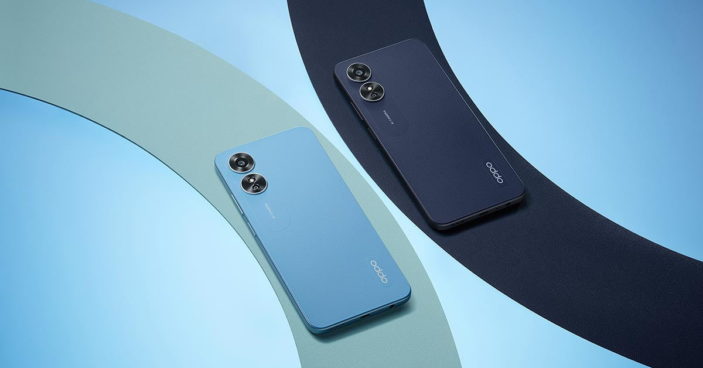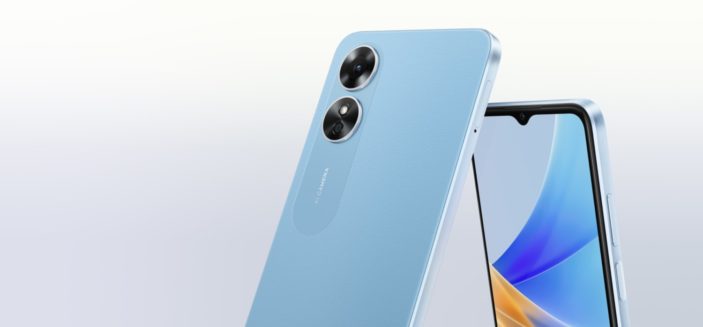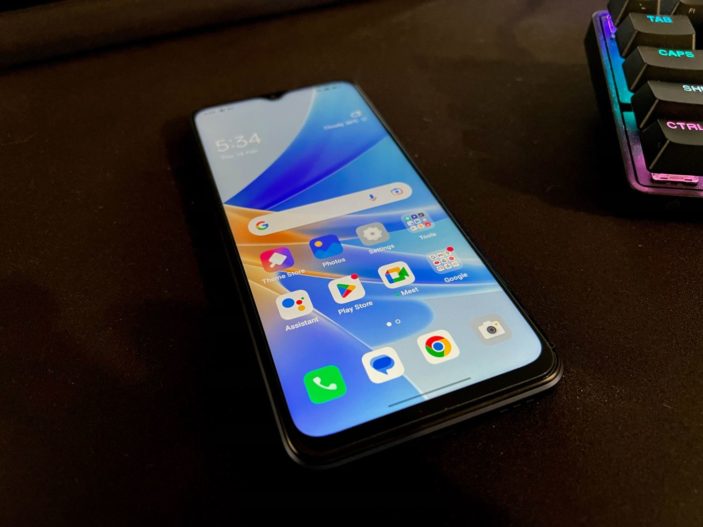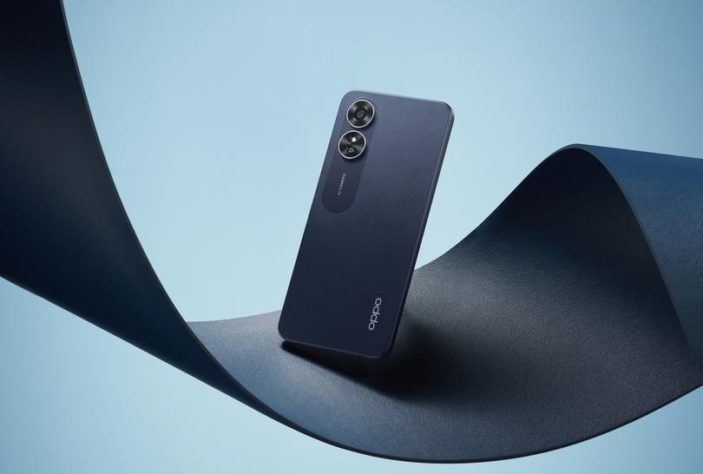
OPPO has long provided mobile phone users with a range of options, from the premium Reno8 Pro and Find X5 Pro models, to lower priced models like the A76 and A96. OPPO have recently decided to redefine their entry-level range with release of the A17. Featuring a premium look and feel, the A17 will provide users with most of the features they’ve become accustomed to in the smartphone game over the past couple of years. That being said, the A17 does cut a few corners in a bid to prioritise the lower A$259 price point. Daily users who want nothing more than calls, texts and occasional social media scrolling will be satisfied, while those looking for faster performance and charging, cleaner photos and a sharper screen may be left looking towards the mid-range for some of OPPO’s more feature-packed phones.
Design
The OPPO A17 is undoubtedly sleek, coming in either a Midnight Black or Lake Blue colourways. We received the Midnight Black, and must admit that its understated darkened bezels help it feel rather minimal and unobtrusive when laying around. At 189g, it’s also one of the lighter phones I’ve ever used, although anything feels lighter when your daily driver weighs as much as the iPhone 13 Pro Max does. The highlight of the overall design comes from the leather-grain patterned PMMA backing, which greatly adds to the premium look and feel the A17 is going for. It’s relatively resistant to fingerprints and scuffs, although I do question how long this would last in good shape without a case in certain tougher conditions.

The surrounding plastic frame comes with a standard lock button, which also doubles as a fingerprint sensor, and volume rocker all conveniently placed on the right side. You’ll also find a standard 3.5mm jack on the bottom left for use with wired headphones and mono-down firing speaker on the bottom right. For the most part, there’s not much else to write home about with the design of the A17; but I also wouldn’t want to criticise something that was never an issue in the first place, particularly when it comes to both value and useability.
Screen
The 6.56 inch, 60hz IPS LCD display features a 1612p x 720p resolution. While many wouldn’t ask for more given the entry-level price, it also feels as though the A17 won’t age particularly well, given the Motorola Moto G62 5G model is providing a 120hz display for around A$350. The toughened Panda glass up front also adds a solid layer of durability for those worried about small drops and bumps.

Screen brightness also caps out at 600 nits, which isn’t terribly bright, but suitable for indoor use. Users who are planning to spend more of their day outside might find themselves squinting to fight through glare on a sunny day, affecting general scrolling, photography accuracy when framing and reading long portions of text.
Performance
Performance is unfortunately a mixed bag. The A17 comes paired with the 12nm octa-core Mediatek MT6765 Helio G35 processor, which is undoubtedly slow. Apps take a couple seconds to open at times, particularly when they haven’t been used in a while, and certain apps like Facebook and Instagram hiccup often when scrolling. The A17 does find it’s footing regularly, and never stutters for too long, but when consistency is key, and the A17 is anything but. ColourOS returns with Android 12 at the wheel, which is a nice fit in making the phone feel both modern and updated to stand alongside its more premium siblings. With 2 years of security updates available for most phones, users may not see a larger OS update hit the A17.
With 4GB RAM and 64GB of eMMC storage on board, users can breathe a sigh of relief with expandable storage, something the premium OPPO models have recently done away with. Users can pop in up to 1TB of MicroSD storage, even if the 80/27MBps read speeds are a little underwhelming when it comes to general performance. The A17 also features Wi-Fi 5 technology, but no NFC, making this a tricky option for anyone that wants to leave their wallet at home.

It’s also worth noting that the Mediatek MT6765 Helio G35 processor absolutely crumbles under pressure when gaming. I’m more than willing to admit that Call of Duty: Mobile is not the regular gaming benchmark for many cheaper smartphones, but it cannot be stressed enough that the A17 should not be considered a gaming phone, particularly for those looking to jump onto more demanding apps and games so consistently. General security features hold up relatively well, with both facial recognition and a lock button allowing for flexibility when your face might be covered for example.
The single down firing mono speaker puts out maximum volume at 80dB, which is also a little underwhelming considering it lacks many of the heavier bass and lower levels that comes with consistent streaming. Thankfully, the included 3.5mm audio jack will save the day for some, with analogue sound available for those using wired headphones and headsets. The upper mono earpiece is relatively fine for calls, and the single microphone does the job indoors, but will more than likely be affected outdoors by strong winds and the inability to pick up surrounding sounds and distant voices that might be relying on loudspeaker calls.
Camera
The A17 packs in a rear 50MP sensor with 12.5MP binning, along with a 5MP front camera. It’s admittedly great at capturing light indoors, with general AI adding an impressive layer of polish and sheen to environments, even if skin colours are a little exaggerated. But in low light, AI will struggle, mainly due to that Mediatek MT6765 Helio G35 processor, making nightography and dynamic range a little difficult for night owls. There is a night mode present here, but it makes little to no difference. Thanks to the 50MP sensor, macro shots and general zoom quality feel great up until 2X zoom; where beyond this, things understandably start to get a little muddy.


Users can also record 1080p video at 30fps, but with little to no stabilisation, it’s worth considering your recording position and situation as shots on the move can look quite shaky. The 1080p quality feels fine, but it’s worth sacrificing resolution for vibrancy here, as 720p recordings bring out a wider colour range in most cases.
Battery
With a 5,000 mAh battery on board, the A17 is more than likely going to last users the entire day and into the next. But I would recommend users keep their battery topped up when possible, mainly due to slower, 10W micro-USB charging. Yes, you read that right, micro-USB charging. For as modern and updated as the A17 looks and feels, this sticks out like a sore thumb. Even though a full charge only takes around 3 hours, it’s simply strange to see OPPO taking a turn towards older technology, particularly when some of their midrange phones support ridiculously fast SuperVOOC charging and generally faster USB-C charging in OPPO phones like the A96, which provides 33W charging and can be picked up for under A$300.
Verdict & Value
The OPPO A17 is a perfectly suitable phone; for the right user. The Mediatek MT6765 Helio G35 processor does hold it back from certain standards, but for everyday users who want to make the most out of calls, texts, social media and the occasional photo while saving a buck or two, the A17 will do just fine. But for those who either use their phone more regularly for streaming, gaming and photos, the A17 leaves a little more top be desired. Make no mistake, at $259, the A17 is well priced and competitive amongst similarly priced phones in the market; but I feel as though that market is only getting smaller.
![]()
![]()
![]()
![]()
![]()
TWO AND A HALF STARS (OUT OF FIVE)
Highlights: Sleek design; Premium backing; Camera holds up indoors
Lowlights: Lacklustre performance; Micro-USB charging is slow and dated; Average sound quality
Manufacturer: Oppo
Price: A$259
Available: Now
Review based on unit supplied by Oppo.
